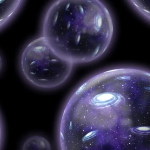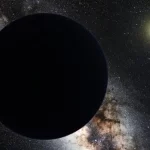- Theia’s Hidden Remains: Scientists propose that remnants of Theia, the protoplanet that collided with Earth to form the Moon, may be buried deep within Earth’s mantle.
- Mysterious Continent-Size Layers: Two massive rock layers, known as Large Low-Shear Velocity Provinces (LLSVPs), beneath West Africa and the Pacific Ocean have intrigued scientists due to their size and density.
- Isotopic Evidence: Recent isotopic evidence and modeling suggest that these LLSVPs might actually be remnants of Theia itself, contrary to previous theories.
- Massive Impactor Theia: New insights propose that Theia, the impacting body, was nearly as large as Earth, challenging earlier theories about its size.
- Lingering Mystery: While the hypothesis is intriguing, there is still some uncertainty and debate among scientists regarding the true nature of these mysterious mantle structures.
The mystery surrounding the formation of the Moon and its connection to the protoplanet Theia, which collided with Earth 4.5 billion years ago, has taken an unexpected turn. Recent research suggests that traces of Theia may be concealed deep within Earth’s mantle, shedding new light on the creation of our celestial neighbor.
For years, scientists have been intrigued by enigmatic geological structures called Large Low-Shear Velocity Provinces (LLSVPs) residing beneath West Africa and the Pacific Ocean. These immense, continent-size layers of rock have puzzled researchers due to their size, density, and distinct seismic properties. Seismic waves traveling through these layers slow down, indicating that they differ in composition from the surrounding mantle rock.
The prevailing theories regarding LLSVPs proposed that they could have formed from the early magma ocean of Earth or could be remnants of the protoplanetary mantle rock that survived the Moon-forming collision. However, a bold new hypothesis has emerged, suggesting that the LLSVPs might contain the remnants of Theia itself. This audacious idea challenges previous assumptions and has sparked considerable interest in the scientific community.
The evidence supporting this idea is multifaceted. Geological data from Iceland and Samoa indicates that the LLSVPs existed at the time of the Moon-forming impact. Seismic imaging has revealed plumes of magma connecting these structures to volcanic activity on these islands, and isotopic analysis of lavas in these regions suggests that they bear a record of Earth’s early history.
Furthermore, recent research by astrophysicist Steven Desch indicates that Theia, the impacting body, was significantly larger than previously believed. Analysis of hydrogen isotope ratios in Moon rocks suggests that Theia was not only massive but also relatively dry, with a mantle more iron-rich than Earth’s current mantle.
Modeling the fate of Theia after the collision provides additional support for the hypothesis. Simulations suggest that Theia’s core merged with Earth, while portions of its mantle, denser than Earth’s, may have survived and descended to the mantle’s base. This scenario aligns with the isotopic evidence, creating a compelling case.
The implications of this hypothesis are significant. If the LLSVPs do indeed contain remnants of Theia, it would explain their massive size, as the protoplanet’s impact would be required to deliver such colossal structures to Earth’s depths.
However, the idea is not without its uncertainties. Some scientists argue that the structure of the LLSVPs could be different from what has been proposed, and they might not extend as deeply as initially thought. There are also debates about the density distribution within these structures.
Intriguingly, if Theia’s remnants are indeed present within Earth’s mantle, it raises the possibility that other smaller, ultradense pockets of material in the mantle might be remnants of other impacting bodies from Earth’s early history. This hypothesis adds a new layer of complexity to the understanding of our planet’s geological history and its cosmic interactions.
While the proposal that Theia’s remnants reside within Earth’s mantle is captivating, it underscores the ever-evolving nature of scientific discovery and the ongoing quest to unravel the mysteries of our planet’s past. As researchers continue to investigate, future missions to the Moon’s south pole by NASA and China may provide valuable data to support or refute this groundbreaking hypothesis, offering a new chapter in the story of Earth and its celestial neighbors.


